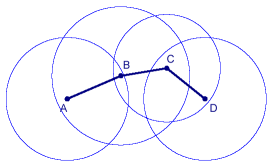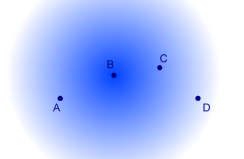Opportunistic Routing: Difference between revisions
mNo edit summary |
|||
| Line 7: | Line 7: | ||
[[Image:links_wired.png]] |
[[Image:links_wired.png]] |
||
As this picture shows, the model sees all nodes within a certain range of each other to be linked, all other nodes to be not linked. This enables protocols known from wired networks to be applied: Static routes are chosen before a packet is sent through the network. Unfortunately, this masks the all the wonderful wireless characteristics: In wireless networks, all nodes - in principle - can communicate with each other: |
|||
[[Image:links_wirelesscircle.png]] [[Image:links_wireless.png]] |
[[Image:links_wirelesscircle.png]] [[Image:links_wireless.png]] |
||
Revision as of 22:31, 7 February 2005
still under construction
Introduction
Most conventional approaches for routing in MANETs (mobile ad-hoc networks) use a model, which is deviated from the wired model: Each pair of nodes is seen either as linked or not linked, only linked nodes can communicate directly:
As this picture shows, the model sees all nodes within a certain range of each other to be linked, all other nodes to be not linked. This enables protocols known from wired networks to be applied: Static routes are chosen before a packet is sent through the network. Unfortunately, this masks the all the wonderful wireless characteristics: In wireless networks, all nodes - in principle - can communicate with each other:
The error rate may be high, but most pairs of nodes have at least a minimal chance of hearing each others packets (in a non-deterministic manner). Even more: Every node receives all packets which are sent by all of its neighbours, which is a difference to wired networks where all communication is somehow directed. The new approach, called "Extremely Opportunistic Routing" tries to use the advantages of these characteristics, to create a more powerful routing protocol for MANETs.


